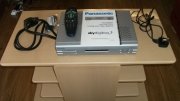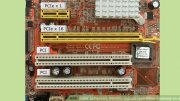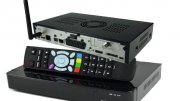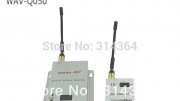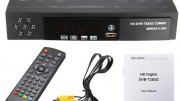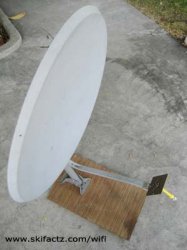
Repurpose the Junky Old Dish
A satellite dish is a powerfull signal booster when used in combination with a WiFi biquad antenna. I see lots of satellite dishes laying in trash when driving. Grab one next time you see an old dish laying on the sidewalk.
I have tried using both smaller Dish Net dishes and larger 76cm (30 inch) dishes [Fig. 1].
They both work well. The larger dish will give you some extra gain but even the small one works really well. How far you can go with this booster?
I have tested it up to 250m (820 feet) with Netgear router on the other end and it worked flawlessly. The router was using the stock antenna it came with.
 First disconnect the so called LNBF from the dish [Fig 2]. Then mount your biquad antenna in place of the LNBF. Ideally, it should be in the exact same position as this is the focal point of the parabolic dish.
First disconnect the so called LNBF from the dish [Fig 2]. Then mount your biquad antenna in place of the LNBF. Ideally, it should be in the exact same position as this is the focal point of the parabolic dish.
You can mount the “naked” biquad [Fig. 3] or place it in an enclosure first which will protect it from weather [Fig. 4].
The actual rigging method is something you’ll have to decide based on the materials you have. I tried mounting the antenna directly to the arm of the dish [Fig. 3].
This method works well but all exposed copper pieces will oxidize quickly. In addition, an exposed antenna can be easily damaged should the dish lose footing.
A better way is to house the antenna in an enclosure and mount it using a support made of PVC electrical conduit pieces [Fig. 5].
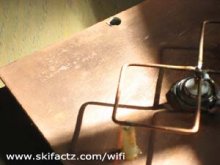 This method was useful on a Dish Net parabolic dish to elevate the position of the antenna. Dish Net dishes have a chunky LNBF that sits up high. Anything you can do to lift the position of your antenna and make it close to where LNBF sits will help.
This method was useful on a Dish Net parabolic dish to elevate the position of the antenna. Dish Net dishes have a chunky LNBF that sits up high. Anything you can do to lift the position of your antenna and make it close to where LNBF sits will help.
Make a provision to rotate the antenna 90 degrees [Fig 6]. The ability to rotate 90 degrees will allow you to match the polarization of the distant antenna you’re connecting to.
All satellite dishes are designed to point up to the sky.
Even when the dish is seemingly 90 degrees to the ground it is still looking up. To properly aim the beam you will need to point the dish down [Fig. 7].
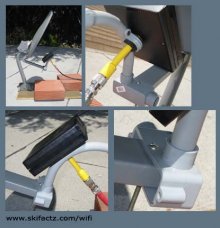 If you are on a hill you will need to point down even more.
If you are on a hill you will need to point down even more.
Now it’s only a matter of fine tunning the position of the dish. Using a free tool like Netstumbler is a good way to aim your dish properly. Once you lock the maximum signal tighten the screws on the dish and rotate the antenna 90 degrees. One of the two polarization positions will give you stronger reception.
Securing the dish with bricks like I’m doing in this picture is a very bad idea. Winds can easily knock the dish down or lift it off your roof. Use something heavy to hold the dish down while locating a good spot to place it. Once you find the spot mount the dish permanently with heavy screws.
Keep in mind that RF cable attenuates high frequency signal a lot. Keep the cable run at the absolute minimum or else all the signal gain of the antenna will be devoured by the cable.
If you don’t have a proper WiFi directional antenna, you could try mounting a USB wireless adapter on the dish instead.
Source: www.skifactz.com
Related posts:

